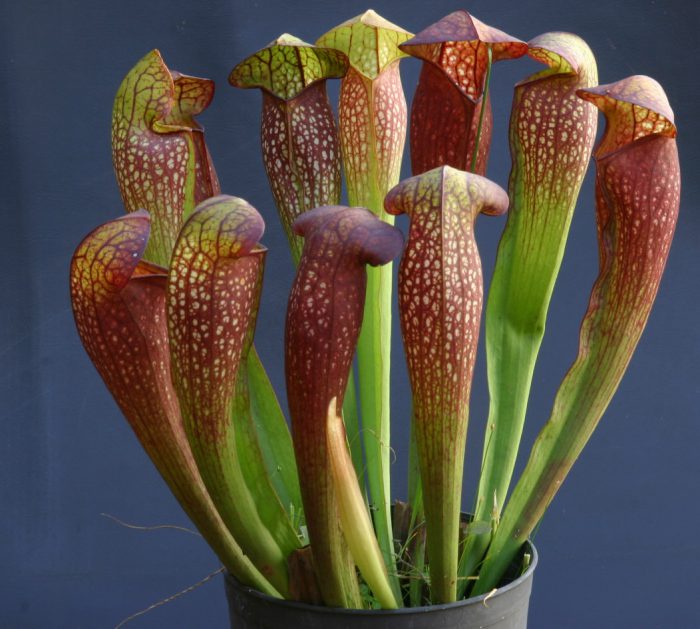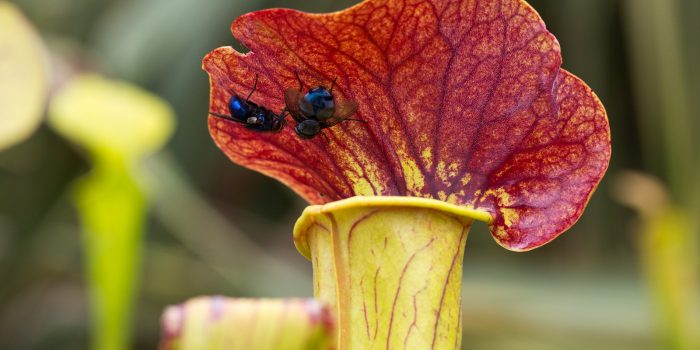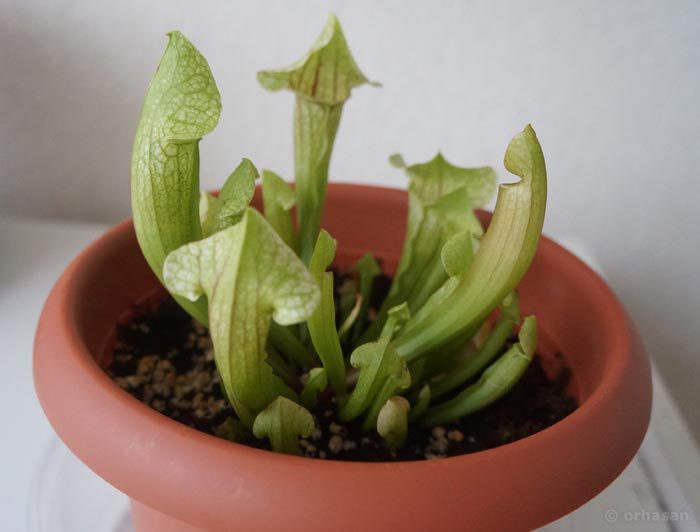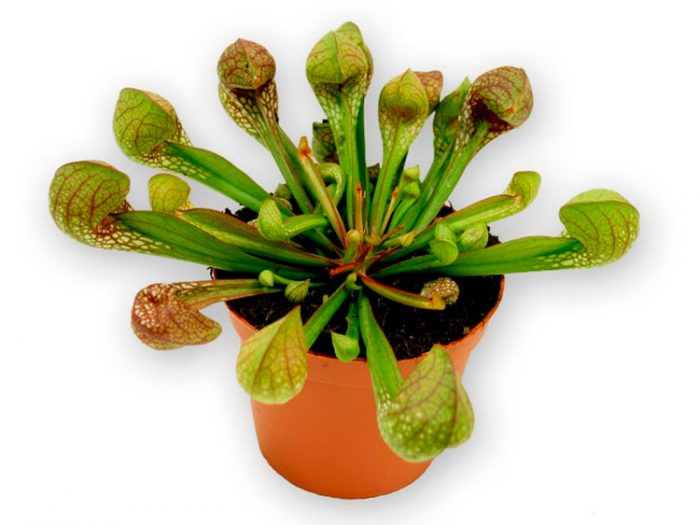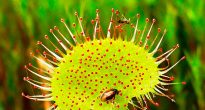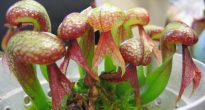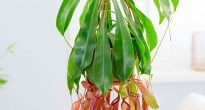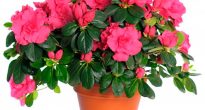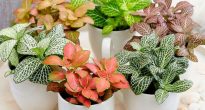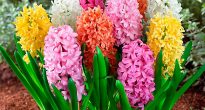Sarracenia - this bog, rhizome, herbaceous plant is a perennial. It is one of the largest carnivorous plants. Its leaves, located below, are scaly. Short-peaked trapping leaves, which are rather large, are collected in a socket. They rise above the plant itself and the structure are somewhat reminiscent of an urn with a rather wide opening on top or a tubular jug.
This plant can only live in certain places, as it is endemic. So, it grows well and develops in the Atlantic-North American Floristic Zone. However, the purple sarracenia (Sarracenia purpurea), introduced to the swampy areas of Central Ireland, has perfectly settled there.
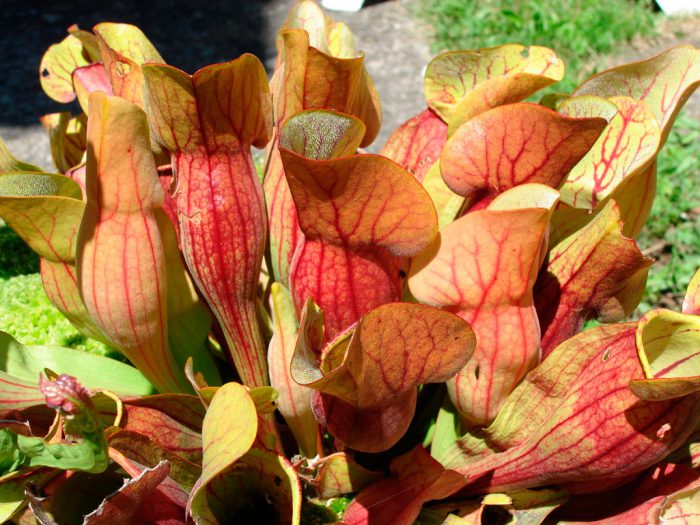
The flowers are quite large and rich in color, they have a double perianth. They rise above the plant on a strong peduncle without leaves, of which there are from 1 to 3 per individual. This plant is distinguished by a very large, bizarrely shaped column in the form of an umbrella. It has not very large stigmas under the apex of each blade. In sarracenia purple, it is the largest in size.
There are such species, including the yellow sarracenia (Sarracenia flava), which form huge thickets in swampy areas. The tubular, ribbed pitchers of this plant extend almost vertically from the strong horizontal rhizome. In length, they can be about 70 or 80 centimeters.

In other species, pitchers-traps are smaller and in length they reach from 10 to 40 centimeters. Most of them have a variegated color, in which yellow, purple and green predominate. The pattern located near the entrance to the trap is painted in the most intense colors, which makes it very visible to insects (even from a distance). Each trapping leaf has a pterygoid fringe on the side of the shoot. And its upper part is very similar to the lid. It plays the role of a kind of "umbrella", which is created from the upper blade of the leaf. It slightly closes the entrance to the trap, protecting it from raindrops.
The insect prey is attracted by the very strong aroma of nectar. And its creator is a nectar-bearing gland, capable of forming relatively large quantities of nectar. An insect caught on a trapping leaf slides down the honey path. Inside, on the surface of the walls of such traps, there are special hairs that allow the victim to move exclusively downward. Then the victim finds himself in a storage trap, and from there he cannot get out in any way. After that, it gradually dissolves in the digestive juice.As a result, the plant receives the nitrogen, magnesium, calcium, and potassium necessary for its life.
Interestingly, various birds consider the sarracenia to be a kind of feeder. They often peck insects that are not yet completely digested. There is information from scientists who say that in such trap jugs, in several cases, the remains of small tree frogs were found.
There are insects that can live comfortably inside these pitchers-traps. The fact is that they are capable of producing special substances that protect the insect from the effects of digestive juice. D. Fish (1976) studied this in more detail, and he writes that the larvae of the meatfly, the night moth with its larvae and the sphex wasp, which manages to make its nests there, can live in trap jugs. These insects destroy most of the victims trapped in the trap. They also significantly damage the leaf tissue, from which the traps can no longer function normally. As a result, these insects are capable of very much harm to entire populations of Sarracenia.
There are very decorative sarracenia species, and in some countries they have been grown for a very long time. The most popular is the yellow sarracenia. It is an ornamental perennial plant that has large, light orange flowers as well as juicy, beautifully curved light green pitchers. If at home they are provided with proper care and watered abundantly, then these plants will feel great even without additional feeding with insects. Also, purple sarracenia is very popular. Its fragrant flowers smell pleasantly of violets.
In just a few species of such a plant, the alkaloid saracenine was found in the leaves, as well as in other aerial parts. It is used in medicine.
Content
Caring for sarraceny at home
Earth mixture
In order for this plant to feel good and grow normally, it needs special soil. So, in natural conditions, it prefers to grow on river and lake shores, and also in swamps. At home, it can be planted in the immediate vicinity of a pool or an artificial pond. When planting in a container, you will need an earth mixture consisting of 2 parts of perlite, 4 parts of peat and 1 part of building sand. The pH should be approximately equal to 5-6.
Top dressing
In no case should you feed, since the introduction of even a small dose of fertilizer can destroy the plant.
How to water
In the event that this carnivore is planted near a pond in the garden, then it should not be watered. It will take the required amount of liquid from the soil. When grown in a container, water should be sufficient. The soil must be moistened all the time. In winter, watering should be slightly reduced, since the plant begins a dormant period. During intensive growth, you need to ensure that the flowerpot is in the water to a height of about 25 millimeters. In the period from October to April, watering should be carried out 1 time in 7 days. When the transplant is carried out, you need to increase the watering. So, at this time it is necessary to water the sarcenia 1 time per day.
Illumination
Loves light very much. The plant simply needs 8-10 hours a day under bright sunlight. Therefore, it is recommended to place it in the room by the window of a western or southern orientation. You can also provide supplementary lighting with fluorescent lamps.
Choosing a container or pot
Due to the fact that the plant prefers to grow in moist, well-drained soil, the container or pot should meet these requirements as much as possible.
It is recommended to opt for pots made of plastic or glass.They should have good drainage holes at the bottom, through which excess liquid will flow. Containers made of porous materials are not suitable in this case. This is because they absorb a lot of water.
Transplant features
It is a fast growing plant. And with proper care, its root system can quickly become cramped in the pot. In this regard, the transplant should be systematic and it is better to carry it out in the spring, when the dormant period ends. A container of not very large size should be chosen for planting.
Reproduction methods
Can be propagated by seeds. It is recommended to sow them in Petri dishes on peat. The grown seedlings dive into separate small pots. Before sowing, the seeds must be prepared. For this, for 1–2 months, they must be subjected to cold stratification. Without this they will not ascend. Sarracenia yellow can be propagated by dividing the rhizome. It should be noted that the plant must be sufficiently expanded. If you divide the bush very often, then the plant becomes noticeably smaller and may die altogether.
Diseases and pests
In the summer time can settle spider mite or aphid... Rot (fungus botrytis) is common in winter.

